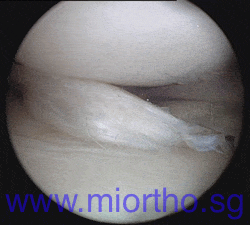The medial meniscus (inner side of knee) and the lateral meniscus (outer side) lie between the joint surfaces of the thigh and leg bones. They act as "cartilage cushions" for the articular cartilage (the white joint surface bearing cartilage) of the knee, distributing the loads evenly in the knee.

The normal function of the meniscii (meniscus singular, meniscii plural) is vital in ensuring that the bearing surfaces of our knees last as long as possible. Meniscus tears can occur in young people, usually in association with twisting injuries in which other ligaments (like the ACL) may also be injured. Meniscus tears are also common in older people. In patients in their 40s and 50s, the meniscii are less flexible and more brittle with age, and this increases the risk of them tearing (so-called degenerative tears), just from simple day to day activities.
Symptoms of a meniscus tear include a history of knee injury, knee swelling and pain over the joint lines. Sometimes, patients may describe a feeling of clicking and sudden painful catching in the knee, which may be related to a meniscus tear which is unstable, and is snapping back and forth when the knee moves.
The diagnosis is made by a good history taking, clinical examination, and usually an MRI (Magnetic Resonance Imaging) scan of the knee.
Some simple meniscus tears may heal on their own in 6-8 weeks. Unfortunately, many do not, and may continue to cause pain, clicking, swelling, or restrict normal knee motion. Ultimately, arthroscopic (keyhole) meniscus surgery may be required.

